Massive Squid Run in Southern California!
Sep 03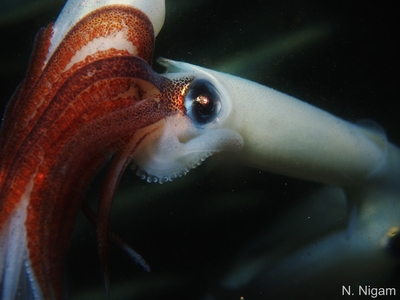
Summer Lovin’ at Veterans Park
By: Nirupam Nigam
As we swam slowly to the edge of the slope that eventually dropped into the Redondo submarine canyon 2000 feet below, we began to see signs of what was to come. Small, shriveled carcasses hovered two inches above the sand, swaying gently surge. A little white sack, looking somewhat like a single white sausage link, moved with it. Target shrimp scurried towards the carcass to fill their already full stomachs. I was about to witness one of the most renowned events of Veterans Park – the squid run.
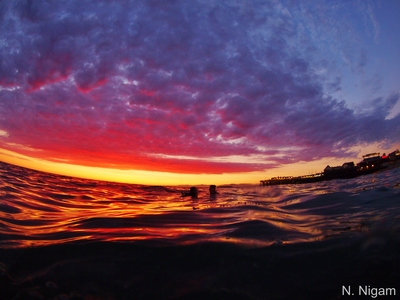
A beautiful sunset before the squid run at Veterans Park
Veterans Park is a popular dive site usually used for training dives next to the Redondo Pier in Redondo Beach, California. It is also well known for its amazing night dives filled with thousands of outlandish creatures ranging from elbow crabs to bay pipefish. The reason for this density and variety of life lies approximately 400 yards from the beach – the Redondo Submarine Canyon. This canyon is responsible for upwelling events that bring cold, nutrient rich water up from the abyss to the Veterans Park dive site. With these events come the sea creatures.
The common market squid (Loligo opalescensis) is one such species that rises from the depths of the canyon. These forearm-sized squid spend most of their life feeding in shoals at depths of approximately 1500 feet. At the end of their twelve to fourteen month life span, thousands upon thousands of individuals take a final swim into the shallows, mate to exchange DNA, and die.
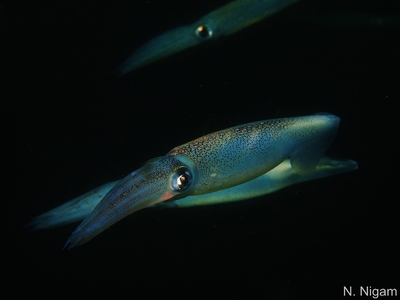
The Common Market Squid
In Southern California, the squid runs are known to occur consistently in mid to late winter. It appears that the squid choose different spots every year, but they generally mate in the same areas (e.g., Veterans Park, La Jolla Shores, Monterey). At Veterans Park the runs happen every few years. This year is definitely an anomaly – the run is occurring in the middle of summer. Despite this fact, the squid run this year is a very strong run. We have been seeing large mating events for at least four days so far! Usually these events last strongly only for two to three days…
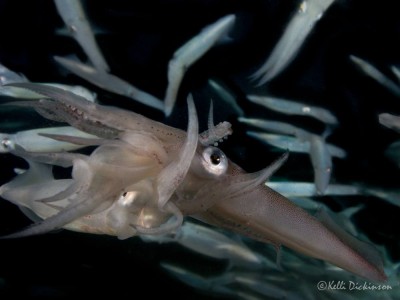
Mating squid, by Kelli Dickinson
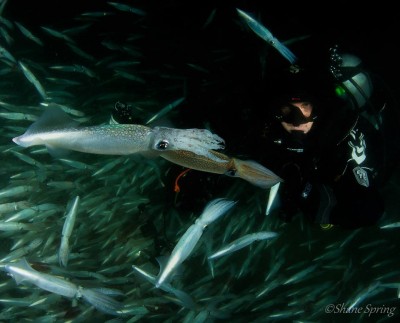
A diver in the middle of the action. By Shane Spring
When squid mate, they congregate in vast numbers – each individual a bouncing ball of sex-drive. Males latch onto females with their tentacles and pass packets of sperm to the females. In the process, the males’ tentacles turn bright red. Females receive the packets and use them to fertilize a single egg sac. Each sac contains 180-300 eggs and is protected by a sheath of bacteria that serves to protect the eggs from fungus and other bacteria. It also deters other animals from eating the eggs. After mating, the tired squid become arthritic and off-colored. The life slowly drains from their body and eyes and their existence ends in the stomachs of the many feasting bat rays, cormorants, sea lions, and crabs. All that remains is a never-ending plain of squid egg-baskets that will hatch 3-5 weeks later.
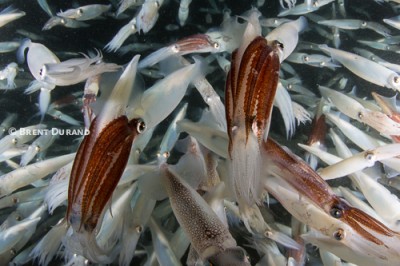
A wall of mating squid, by Brent Durand
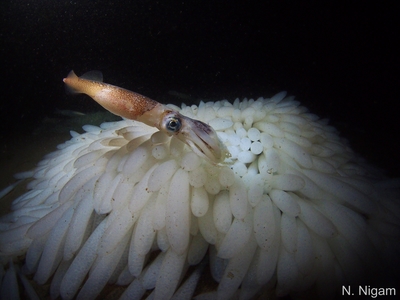
A female squid adding her eggs to the basket
This description of the run from a few days ago by Claudette Dorsey says it all:
“I just had my face washed by 80,000 squid.
Like walking through a car wash of squid.
Tickled by tentacles against my cheeks and lips and chin.
Blown upon by thousands of pulsing little squid jets.
Bumped and prodded, head to toe, by hundreds of muscle’y missiles all at once.
Ronnie had a squid lay an egg case on her ring finger.
That is some kind of wild proposal from the Cephalopod Kingdom.
Making eye contact with Ronnie I noticed something amazing for a night dive: I could see her face and eyes clearly. Usually faces are dark at night because we’re careful to point lights away from buddy’s face.
Tonight I could see Ronnie’s face… in the light reflected by thousands and thousands of pearlescent squid.
And then I couldn’t see her at all because a moving wall of squid intervened.
There were many squid.
There were 2 divers.
Last time I experienced this was 2005, with Carlos Barrios, and I was so cold in a wetsuit at 65fsw it was almost unbearable.
Tonight we had over 80 dry-suited minutes of squid happiness, from the deepest point at 128fsw up to the the squid filled deco stop at 18fsw watching a crab grab at squid tentacles like a kid leaping for balloon strings.
Day squid are majestic.
Late night squid are a primeval rave.
Incantatory genetic ecstasy.
Time to sleep, dream of dive travel and be back at 0700 for more.”
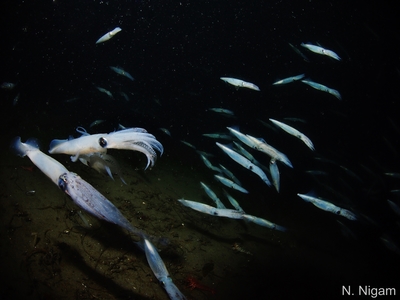
Squid getting ready for a long night at Vets





Related Articles
Popular Articles